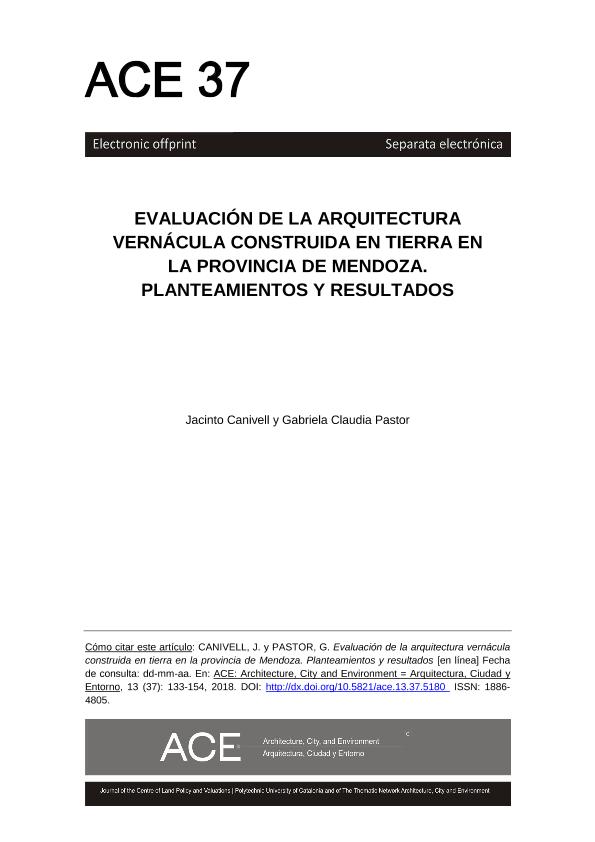Mostrar el registro sencillo del ítem
dc.contributor.author
Canivell, Jacinto
dc.contributor.author
Pastor, Gabriela Claudia

dc.date.available
2019-11-07T18:10:55Z
dc.date.issued
2018-06
dc.identifier.citation
Canivell, Jacinto; Pastor, Gabriela Claudia; Evaluación de la arquitectura vernácula construida en tierra en la provincia de mendoza: Planteamientos y resultados; Universitat Politècnica de Catalunya; Architecture, City and Environment; 12; 37; 6-2018; 133-154
dc.identifier.issn
1886-4805
dc.identifier.uri
http://hdl.handle.net/11336/88195
dc.description.abstract
El patrimonio construido en Argentina, aunque relativamente joven en términos cronológicos, es amplio y diverso. Las edificaciones vernáculas, aquellas realizadas con medios y técnicas tradicionales y estrechamente ligadas a la cultura popular y anónima, constituyen buena parte de ese patrimonio material e inmaterial, ya que se fundamentan en la propia cultura popular y en sus tradiciones constructivas. Aunque en general en Argentina todo el patrimonio edificado es vulnerable, en el caso de la provincia de Mendoza es más evidente fundamentalmente por sus condiciones ambientales. Este trabajo plantea una evaluación del patrimonio vernáculo en norte de la provincia de Mendoza, con el fin de identificar las claves de su degradación, el estado de las tradiciones constructivas y de sus perspectivas y posibilidades a futuro.
dc.description.abstract
The built heritage in Argentina is wide and diverse, although relatively new in chronological terms. Vernacular buildings are made by traditional means and strongly associated to the anonymous and popular culture. They comprise a large portion of that tangible and intangible heritage since it is based on the popular culture itself and on its constructive traditions. Although the built heritage in Argentina is in general at risk, is more evident in the case of the province of Mendoza, due to its environmental conditions. This work proposes an assessment of the vernacular heritage in the north of the province of Mendoza in order to point out the keys of its deterioration, the condition of the constructive traditions and their future prospects. Methodology For that purpose, a sampling of the cases was carried out according to relevant situations where this type of architecture is prominent. The current situation and the perspectives are suggested by means of several surveying, evaluation and diagnostic tools. Conclusions Failure and risk assessment proves that the cause of the deterioration is not the assumed weakness of the traditional technique. Furthermore, the seismic risk may be low if the construction quality is adequate. It is confirmed that traditional building techniques are currently more threatened in urban areas due to their association as architecture for the poor and to the loss of traditional crafts. Originality The paper is set within a multidisciplinary field, where technological procedures and the key aspects involved in the decision-making policy in "heritage conservation" are identified. Its relevance and original contribution derives from having adopted a quantitative and qualitative methodological perspective on vernacular heritage in order to understand the dynamics of the changes. Besides that, the paper shows de efficient of the informatics tools to analyze different cases in urban and rural territories.
dc.format
application/pdf
dc.language.iso
spa
dc.publisher
Universitat Politècnica de Catalunya

dc.rights
info:eu-repo/semantics/openAccess
dc.rights.uri
https://creativecommons.org/licenses/by-nc-sa/2.5/ar/
dc.subject
ADOBE
dc.subject
CONSTRUCTION TECHNIQUES
dc.subject
RAMMED EARTH
dc.subject
RISK
dc.subject
WATTLE AND DAUB
dc.subject.classification
Ciencias Sociales Interdisciplinarias

dc.subject.classification
Otras Ciencias Sociales

dc.subject.classification
CIENCIAS SOCIALES

dc.title
Evaluación de la arquitectura vernácula construida en tierra en la provincia de mendoza: Planteamientos y resultados
dc.title
Evaluation of vernacular earthern architecture in the province of mendoza: Approaches and results
dc.type
info:eu-repo/semantics/article
dc.type
info:ar-repo/semantics/artículo
dc.type
info:eu-repo/semantics/publishedVersion
dc.date.updated
2019-10-16T20:58:51Z
dc.journal.volume
12
dc.journal.number
37
dc.journal.pagination
133-154
dc.journal.pais
España

dc.journal.ciudad
Barcelona
dc.description.fil
Fil: Canivell, Jacinto. Universidad de Sevilla; España
dc.description.fil
Fil: Pastor, Gabriela Claudia. Consejo Nacional de Investigaciones Científicas y Técnicas. Centro Científico Tecnológico Conicet - Mendoza. Instituto Argentino de Investigaciones de las Zonas Áridas. Provincia de Mendoza. Instituto Argentino de Investigaciones de las Zonas Áridas. Universidad Nacional de Cuyo. Instituto Argentino de Investigaciones de las Zonas Áridas; Argentina
dc.journal.title
Architecture, City and Environment
dc.relation.alternativeid
info:eu-repo/semantics/altIdentifier/doi/http://dx.doi.org/10.5821/ace.13.37.5180
dc.relation.alternativeid
info:eu-repo/semantics/altIdentifier/url/https://upcommons.upc.edu/handle/2117/118769
Archivos asociados
